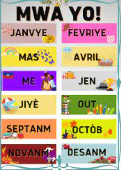
Home Page Neocities.
Haitian Creole, or Kreyòl Ayisyen, is a beautiful language that reflects the fusion of various influences, primarily derived from French but with distinct grammatical structures and vocabulary. Its simplicity and directness are evident in phrases like "Bonjou, kijan ou ye?" which means "Good morning, how are you?" The language's unique phonetics and straightforward grammar often surprise those encountering it for the first time. One of its intriguing features is the use of affixes to convey meaning. For instance, "manje" means "to eat," and by adding the prefix "pou," it becomes "pou manje," which translates to "to eat" or "for eating." Similarly, compounding words is a common practice, such as "lavi" (life) and "bon" (good) combining to create "bon lavi," meaning "good life." Expressions in Haitian Creole also carry cultural nuances. "Kote wap viv?" means "Where do you live?" but directly translates to "Where are you living?" showing the language's tendency to use continuous tense more frequently. Another example, "Mwen renmen ou anpil," translates to "I love you very much," highlighting the importance of affectionate expression in the language. This language serves as a vital tool for communication but also holds deep cultural significance, manifesting in traditional stories, music, and everyday interactions among Haitians. Its evolution and resilience are a testament to the strength of Haiti's history and heritage.Haitian Creole's evolution and resilience have fostered a unique identity, showcasing its adaptability and inclusivity. Its vocabulary integrates elements from African languages, Taíno, Spanish, and English, offering a diverse linguistic tapestry. For instance, the word "zombi" originates from Haitian Creole and has found its way into various languages worldwide, signifying the cross-cultural influence of Kreyòl. The language's significance extends beyond daily communication, permeating Haitian literature and oral traditions. Renowned writers like Jacques Roumain and Edwidge Danticat have contributed immensely to Haitian literature, utilizing Kreyòl to capture the essence of Haitian experiences. From folk tales passed down through generations to contemporary literature, Haitian Creole serves as a bridge connecting past, present, and future, preserving the country's rich heritage. Moreover, initiatives to promote and standardize Haitian Creole in education and media reflect its growing importance. Efforts to establish it as an official language alongside French further validate its role in shaping Haiti's cultural and national identity. As Haiti continues to embrace and celebrate its linguistic diversity, Haitian Creole remains an integral part of the nation's story, a testament to resilience, cultural richness, and the spirit of its people. bold and italic text.
Months

